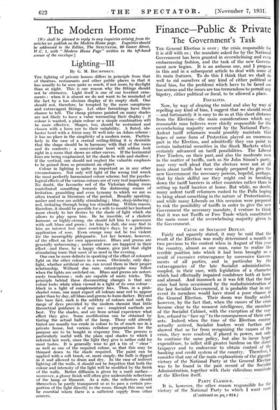The Modern Home
[Tr e shall be pkased to reply to any inquiries arising from the articles we publish on the Modern Home page. Inquiries should be addressed to the Editor, The SPECTATOR, 99 Gower Street, TT'.C. I, with " Modern Home Page" written in the left-hand corner of the envelope.]
By G. M. BOUMPHREY.
THE lighting of private houses differs in principle from that of theatres, restaurants and other public places in that it has usually to be seen quite as much, if not more, by daylight than at night. This is one reason why the fittings should not be obtrusive. Light itself is one of our loveliest orna- ments : when it is absent we do not want to be reminded of the fact_ by a too obvious display of its empty shell. One should not, therefore, be tempted by the more sumptuous and extravagant fittings. Let other furnishings have their chance to tell. The cheap pictures painted on many shades are not likely to have a value warranting their display ; if colour is wanted, a plain colour or a simple combination will be more effective. Shapes, too; should be restrained and chosen with a keen eye to their suitability. A fluted, ala- baster bowl with a frieze may fit well into an Adam scheme : it has no place in the simplicity of a modern room. Particu- larly in the case of a central ceiling-fitting it is desirable that the shape should be in harmony with that of the room and its contents : a semi-circular bowl will seldom look right in a room that shows no other curves. If the horizontal lines are being emphasized, let the shade be wide and shallow ; if the vertical, one should not neglect the valuable emphasis to be gained from so prominent an object.
Colour in lighting is quite as important as in any other circumstances. Not only will light of the wrong tint wreck the most perfectly harmonized colour scheme, but the psycho- logical effects of the various colours are of very real importance. No doubt, the favourite red of the Victorian dining room contributed something towards the distressing scenes of irritation, grumbling and even tyranny to which we are so often treated in literature of the period. Broadly speaking, amber and rose are mildly stimulating ; blue, sleep-inducing ; red, irritating through being too stimulating. Within reason, therefore, it should be possible for a wife to mould her husband More closely to her desires by the shade of light which she allows to play upon him. Be he irascible, of a choleric humour, or highly-strung, she should lull him to quiescence with soft blues and green ; let him be dull, she may find in bim an interest lost since courtship's days, by a judicious application of rose. Even orange may not be too violent for the incorrigibly phlegmatic. Let her beware, however, of the effect on her own appearance. Blues and greens are generally unbecoming ; amber and rose are happiest in their effect—and these, by a happy chance, give just that slight stimulating tonic that most of us need in the evening.
One can be more definite in speaking of the effect of coloured light on the other colours in a room. Obviously, only day- light, whether artificial or no, can reveal them in their proper relationship. Without due care, catastrophe may follow when the lights are switched on. Blues and greens are notori- ously treacherous ; reds are capable of nasty tricks. The principle behind these disconcerting changes is that any colour looks white when viewed in a light of its own colour— black in a light of complementary fun. Thus, in a pink- shaded room, one must expect all colours near red to appear paler than by day, all blues and greens to loom darker. Beyond this bare fact, such is the subtlety of colours and such the range of dyes provided by the modern chemist that little theoretical guidance is of any use : empirical methods are best. Try the shades, and see from actual experience what effect they give. Some modification can be obtained by tinting the actual bulb of the lamp. Those sold already tinted are usually too crude in colour to be of much use in a private house, but various cellulose preparations for the purpose are to be bought in sixpenny tins. The process is particularly useful with the plain opal shades to which I referred last week, since the light they give is rather cold for most tastes. It is generally wise to get a tin of " clear " as well as one of the required colour, so-that this may be thinned down to the shade required. The paint can be applied with.a soft brush, or, more simply, the bulb is dipped in it and allowed to drain and dry. In the case of indirect lighting off the walls, it should not be forgotten that both the colour and intensity of the light will be modified by the finish of the walls. Better diffusion is given by a matt surface— moreover, a glossy finish will often give undesirable reflections of the lamp or filament. As a rule, the reflectors should themselves be partly transparent so as to pass a certain pro- portion of the light directly to the room, though this may not be essential where there is a sufficient supply from other sources.














































 Previous page
Previous page